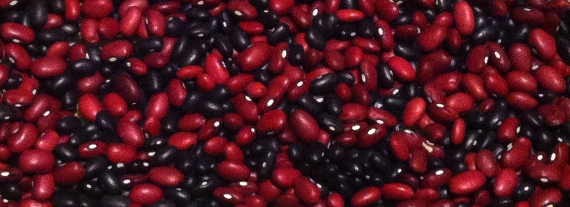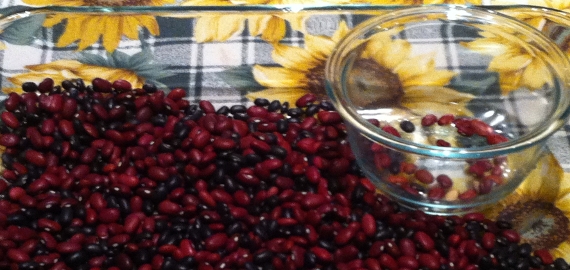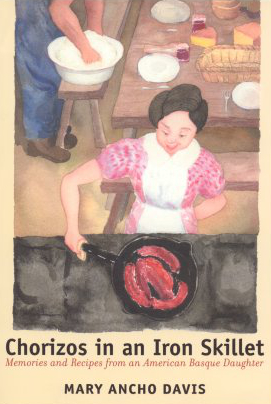Black and Red Turkey Chili
My husband likes really meaty chili, whereas I like more beans and vegetables. This recipe was a compromise between the two differing preferences as well as an adaption of my previously posted chili recipe. It’s also getting colder at night as we move further into autumn, so this makes a rather comforting evening meal. There’s really nothing like a warm bowl of hearty chili to make you feel warm and cozy.
As my tummy has been extra sensitive lately, I made sure that this chili was as “Noel-friendly” and easy to digest as possible. I soaked the beans for a full day, changing out the water half way through. I added baking soda to cut down on the beans’ required cooking time. I skimmed the foam full of “impurities” (such as indigestible sugars and bitter compounds), which can cause bloating and affect the over-all flavor. I added a bunch of turmeric (I thought about adding asafoetida, as well, but didn’t want to stink up the house) and a strip of dried kombu seaweed (contains good bean-digesting enzymes). The spice mix I used contains cayenne pepper, but I added a little extra for more kick. I waited until the beans were tender to add in the salty and acidic ingredients. Just in case, I took a digestive pill, as well. If your stomach is not as touchy as mine is, you do not have to take all of these precautionary steps. All of them were definitely worth the hastle for me though. The chili turned out very tasty indeed. Besides, this chili is filled with protein, which is great, since my husband and I work out at our local gym.
Black and Red Chili Bean Turkey Chili
Adapted from my Turkey Black Bean Chili recipe.
Serve the chili with Paleo Carrot Coconut Muffins (made with cinnamon wildflower honey) and salad with fennel greens to further assist with digestion.
Yields about 30 servings
Ingredients
3 C Dried Red Chili Beans or Kidney Beans
3 C Dried Black Beans
3 to 3 1/2 qt Filtered Water
Extra Virgin Olive Oil
1/2 C + 1 T Minced Garlic
1 1/2 C Chopped Yellow or White Onion
1 1/2 lbs 80% Lean Ground Turkey
3 qt Filtered Water
2 tsp Baking Soda
1 Large Piece Dried Kombu Seaweed
3 T Bean Roundup Spice Mix
3 T Dried Ground Turmeric
2 tsp Dried Ground Cayenne Pepper
1 16-oz Jar Balakain Farms Blended Organic Green Zebra Heirloom Tomatoes
1 C Mild or Medium Salsa Verde or Tomatillo Salsa
2 T Lime Juice
2 T Unfiltered Apple Cider Vinegar
8 T Chicken Better than Bouillon, dissolved in 1 qt Hot Filtered Water
Filtered Water
Optional Garnishes
Cilantro Springs
Scallions, sliced
Avocado, skinned, pitted, thinly sliced
Vegan Sour Cream or Vegan Plain Yogurt
Daiya Cheddar Style Shreds
Daiya Pepperjack Style Shreds
Directions
Sort your beans. Discard any beans that are discolored, under developed, malformed or broken, as well as, any rocks. Rinse the beans with water. Soak the beans for at least 8 to 12 hours or overnight in a large non-reactive bowl with 12 to 14 cups of water, changing out the water about half way through. Rinse with fresh water.
In a large oiled stock pot, saute the garlic and onions until they are tender and clear with a long-handled wooden spoon. Add in and brown the turkey. Stir in the water, baking soda, seaweed, beans and spices. Bring to a boil. With a long-handled ladle or wire mesh, remove any foam that forms on the surface for about 2 to 3 minutes or until the beans stop foaming; I like to keep a little bowl handy to put the foam into. Lower the heat to medium-low and cook covered for 1 hour or until the beans are tender, stirring occasionally. Mix in the tomatoes, salsa, lime, vinegar and diluted bouillon. Cover. Return chili to a boil. Stir. Reduce the heat to low. Cook covered for 1 hour, stirring often to prevent the beans and meat from sticking to the bottom of the pot. Add more water as necessary. Turn off the heat.
Serve and garnish as desired. Enjoy!


 I finally made S & B’s red box of Curry no Ohji-sama with chicken and mixed vegetables. It tasted so good! This variety is a Japanese sweet curry roux mix that was originally intended for children, but I don’t see why adults shouldn’t enjoy it, too. S & B also makes a blue-box version of this curry, too, which has a different flavor (from what I can tell based on the listed ingredients). What exactly the blue-labelled box mix is supposed to taste like is still a mystery to me, but it looks good. For more information, please read the sections I wrote on both varieties
I finally made S & B’s red box of Curry no Ohji-sama with chicken and mixed vegetables. It tasted so good! This variety is a Japanese sweet curry roux mix that was originally intended for children, but I don’t see why adults shouldn’t enjoy it, too. S & B also makes a blue-box version of this curry, too, which has a different flavor (from what I can tell based on the listed ingredients). What exactly the blue-labelled box mix is supposed to taste like is still a mystery to me, but it looks good. For more information, please read the sections I wrote on both varieties 



























